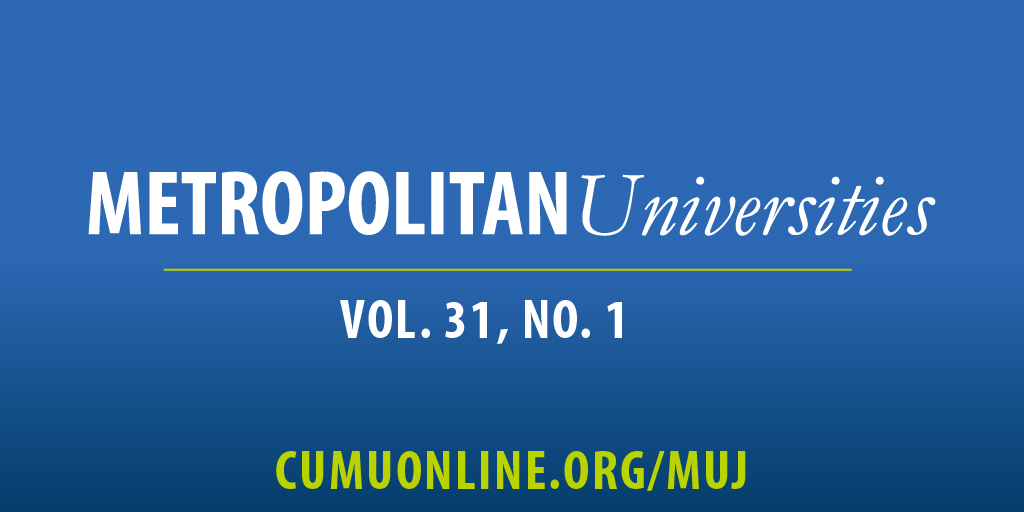Determining the University’s Position in a Multi-stakeholder Collaborative Network
DOI:
https://doi.org/10.18060/22604Keywords:
collaboration management, cross-sector collaborations, social network analysis, social capitalAbstract
Complex problems are being approached through collaborations that cross sectors including businesses, nonprofits, public institutions, and academia. Social Network Analysis (SNA) methods have been adopted to help manage these large collaborations, and it is useful not only for exploring the network dynamics of the collaboration as a whole, but also for exploring where an individual organization lies within the network. Universities can benefit from understanding their position and ties within a network and utilize that information to strengthen their position within these collaborations while fostering collaborations within the network. This study applied SNA to determine the influential position of an urban university within a multi-stakeholder collaborative network (MSCN). The university in this study holds more formal intra-sector relationships and more informal inter-sector relationships with the organization types in the MSCN. The findings also show that the university does hold a prominent position within the informal network of the MSCN; however, it does not hold a position of prominence within the formal network of the MSCN. Fostering these formal and informal relationships would allow the university to strategically promote beneficial collaborations for the university and the network as a whole.
References
Becker, J., & Smith, D. (2018). The Need for Cross-Sector Collaboration. Stanford Social Innovation Review, 16(1), C2-C3. DOI: 10.1016/j.progress.2007.02.003
Benneworth, P., & Hospers, G. J. (2007). Urban competitiveness in the knowledge economy: Universities as new planning animateurs. Progress in Planning, 67(2), 105-197. DOI: 10.1016/j.progress.2007.02.003
Borgatti, S. (2006). Identifying sets of key players in a social network. Computational & Mathematical Organization Theory, 12(1), 21-34. DOI:10.1007/s10588-006-7084-x
Borgatti, S.P. & Ofem, B. 2010, "Overview: Social network theory and analysis" in Social network theory and educational change, ed. A.J. Daly, Cambridge, Mass.: Harvard Education Press, pp. 17.
Brandon, D.P. & Hollingshead, A.B. 2004, Transactive Memory Systems in Organizations: Matching Tasks, Expertise, and People. (2004). Organization Science, 15(6), 633-644.
DOI 10.1287/orsc. 1040.0069
The Connected Company: Finding Value In Informal Employee Networks - The One Brief. (2016). The One Brief. Retrieved from https://theonebrief.com/the-connected-company-finding-value-in-informal-employee-networks/
Etzkowitz, H., Webster, A., Gebhardt, C., & Terra, B. (2000). The future of the university and the university of the future: Evolution of ivory tower to entrepreneurial paradigm. Research Policy, 29(2), 313-330. DOI: 10.1016/S0048-7333(99)00069-4
Goldenberg, J., Han, S., Lehmann, D., & Hong, J. (2009). The Role of Hubs in the Adoption Process. Journal of Marketing, 73(2), 1-13. DOI: 10.1509/jmkg.73.2.1
Guimarães, A., Vieira, A.B., Silva, A.P.C. & Ziviani, A. 2013, "Fast centrality-driven diffusion in dynamic networks", Proceedings of the 22nd International Conference on World Wide Web ACM, pp. 821.
Inkpen, A., & Tsang, E. (2005). Social capital, networks, and knowledge transfer. Academy Of Management Review, 30(1), 146-165. DOI: 10.5465/AMR.2005.15281445
Kenis, P. & Oerlemans, L. 2007, "The Social Network Perspective: Understanding the Structure of Cooperation" in Oxford Handbook of Inter-Organizational Relations, eds. S. Cropper, C. Huxham, M. Ebers & P.S. Ring, Oxford University Press, Oxford, England, UK, pp. 289.
Liu, W., Sidhu, A., Beacom, A.M. & Valente, T.W. 2017, "Social network theory", The international encyclopedia of media effects, pp. 1-12. DOI: 10.1002/9781118783764.wbieme0092
McPherson, M., Smith-Lovin, L., & Cook, J. (2001). Birds of a Feather: Homophily in Social Networks. Annual Review of Sociology, 27, 415-444.
Nahapiet, J., & Ghoshal, S. (1998). Social Capital, Intellectual Capital, and the Organizational Advantage. The Academy of Management Review, 23(2), 242-266. DOI:10.2307/259373
OSE Steering Committee 2017, Omaha STEM Ecosystem Strategic Plan.
Pentland, A. 2015, Social Physics: How social networks can make us smarter, Penguin, New York, NY.
Reagans, R., & Mcevily, B. (2003). Network Structure and Knowledge Transfer: The Effects of Cohesion and Range. Administrative Science Quarterly, 48(2), 240-267. DOI: 10.2307/3556658
Reding, T., Dorn, B., Grandgenett, N., Siy, H., Youn, J., Zhu, Q., & Engelmann, C. (2016). Identification of the Emergent Leaders within a CSE Professional Development Program. Proceedings of the 11th Workshop in Primary and Secondary Computing Education, 13-15, 37-44. DOI: 10.1145/2978249.2978254
Reding, T.E, Sigmon, J., Jafri, J., Smith-Walker, N., & Meyer, E. (2017). Mapping connectedness: social networks analysis and systems thinking in practice. Conference Presentation at Kansas City, MO.
Rogers, E.M. (2010) Diffusion of innovations, Simon and Schuster, New York, NY.
Shaw-Ching Liu, B., Madhavan, R., & Sudharshan, D. (2005). DiffuNET: The impact of network structure on diffusion of innovation. European Journal of Innovation Management,8(2), 240-262. DOI: 10.1108/14601060510594701
Spillane, J.P., Healey, K. & Kim, C.M. (2010) Leading and managing instruction: Formal and informal aspects of the elementary school organization. Social network theory and educational change, 129-158.
Vlaisavljevic, V., Cabello‐Medina, C., & Pérez‐Luño, A. (2016). Coping with Diversity in Alliances for Inno
vation: The Role of Relational Social Capital and Knowledge Codifiability. British Journal of Management, 27(2), 304-322. DOI: 10.1111/1467-8551.12155
Wasserman, S. & Faust, K. (1994) Social network analysis: Methods and applications, Cambridge University Press.
West, M.R. (2014) The Limitations of Self-Report Measures of Non-cognitive Skills, The Brown Center Chalkboard Series, no. 92.



